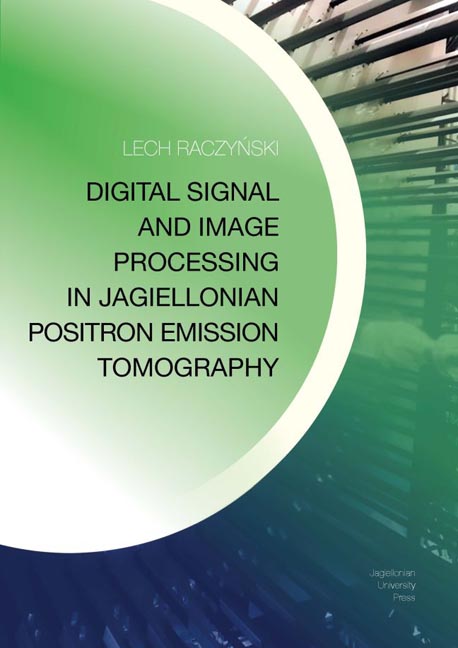Book contents
- Frontmatter
- Dedication
- Acknowledgements
- Contents
- Abbreviations
- Preface
- 1 Introduction
- 2 Positron Emission Tomography
- 3 Algorithmic background
- 4 Low-level data processing in Jagiellonian PET
- 5 High-level data processing in Jagiellonian PET
- 6 Results
- 7 Conclusions and summary
- Appendix
- References
- Miscellaneous Endmatter
4 - Low-level data processing in Jagiellonian PET
Published online by Cambridge University Press: 13 October 2023
- Frontmatter
- Dedication
- Acknowledgements
- Contents
- Abbreviations
- Preface
- 1 Introduction
- 2 Positron Emission Tomography
- 3 Algorithmic background
- 4 Low-level data processing in Jagiellonian PET
- 5 High-level data processing in Jagiellonian PET
- 6 Results
- 7 Conclusions and summary
- Appendix
- References
- Miscellaneous Endmatter
Summary
This chapter describes the subsequent steps of low-level data processing in the J-PET scanner. The goal of low-level reconstruction is an evaluation of time and position of each particular event of positron emission. A simple setup with two detection modules that permits the reconstruction of information about an event is shown in Fig. 4.1.
A single detection module consists of a long scintillator strip and a pair of photomultipliers (PMs) attached to opposite ends of the strip (see Fig. 4.1). The subsequent steps of the reconstruction take place in the reverse order than the physical processes of interactions in the detector. Light pulses produced in the strip propagate to its edges where they are converted via photomultipliers into electric signals. Measurement of electric signals results in timestamps from both sides of each scintillator, allowing the extraction of timing, position and energy information for each γ photon interaction marked with gray circle in Fig. 4.1. The time and position of the γ photon interaction in the scintillator strip is calculated based on times at left (t(L)) and right (t(R)) side of the strip. In the first approximation, the time of interaction may be estimated as an arithmetic mean of t(L) and t(R) and the position of interaction along the strip may be calculated as (t(L) − t(R)) vsc /2, where vsc denotes the speed of light signals in the scintillator strip. The energy deposited in the scintillator strip may be expressed in terms of the number of photoelectrons registered by the photomultipliers and is proportional to the arithmetic mean of a number of photoelectrons registered at the left and right sides of the scintillator; the value of energy calibration factor was evaluated in [17]. The registration of single event of positron emission, used for the image reconstruction, is based on the detection of both γ photons in two modules in a narrow time window. Therefore, a single image-building event, marked with black star in Fig. 4.1, includes information about four times of light signals arrival to the left and right ends of the two modules that register in coincidence.
The two main features of the data acquired in the J-PET scanner that have the greatest impact on the TOF resolution are: (i) a very short rise-time and duration of the signals and (ii) a relation between the shape and amplitude of the signals and the hit position.
- Type
- Chapter
- Information
- Publisher: Jagiellonian University PressPrint publication year: 2021

